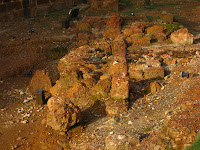 Malacca now boosts another attraction to cash on the tourism dollars. The replica of the Middleburg Bastion is now opened to public when I visited there on Dec 9, 08.
Malacca now boosts another attraction to cash on the tourism dollars. The replica of the Middleburg Bastion is now opened to public when I visited there on Dec 9, 08. The project is not without controversy from the first day its foundation was unearthed by workers constructing the Taming Sari Revolving Tower.
The project is not without controversy from the first day its foundation was unearthed by workers constructing the Taming Sari Revolving Tower.A few parties have voiced conflicting views how best the monument should be preserved.
Ar John Koh in his Badan Warisan column- "The Old Melaka Fort"- even go so far as to accord the site as the next most important archaeological find in the Malay Peninsula after the discovery of Hindu Cendi in Bujang Valley, Kedah.
For hard core conservationists, no viable option is acceptable except to leave the bastion foundation unmolested.
On the other extreme, policy makers were more interested in turning the site into a grand tourism scheme by 'remaking' the bastion.
RM12.8 million and almost a year later and you've another tourist attraction.
Needless to say, critics of the project were aghast at the turn of event.
The entire development took place when no expert could verify the authenticity of bastion design or the height of the wall.
 The bastion was part of a larger fortress the A Famosa - which was first constructed by the Portuguese and reinforced later by the Dutch before British Captain W. Farquhar almost demolished it all in the 18th century.
The bastion was part of a larger fortress the A Famosa - which was first constructed by the Portuguese and reinforced later by the Dutch before British Captain W. Farquhar almost demolished it all in the 18th century.All working reference for the project was based on sketchy illustrations and tell-tales provided by ancient sea farers. Yet the people who mooted the rebuilding task were adamant about giving the project the go-ahead.
Now the bastion project is completed and I am for one tend to agree that maybe the replica could benefit the lay men. It works wonderfully to stir up their imagination of the ancient bastion.


The fact of the matter is that they are the bulk of the visitors to Malacca and historical sites like Middleburg appeal to folks more interested in snapping some memorable pictures but hardly excited with the historical value of this momentous archaeological find.
 Fortunately in my view, a few ingenious designs have been incorporated into this RM12.8 million project and we are able to appreciate the remnants of the original bastion foundation and the laterite coral rocks hidden underneath.
Fortunately in my view, a few ingenious designs have been incorporated into this RM12.8 million project and we are able to appreciate the remnants of the original bastion foundation and the laterite coral rocks hidden underneath.Walk around the structure and you could find a few openings in the ground previously discovered by archaeologists to give visitors some insights about the original foundation.
Visitors however, will be disappointed to find information on the bastion lacking because there are no captions available but I believe this would be overcome soon.


My favorite is the glass bridge next to the main structure if one is on their way to the top of bastion.
It allows visitors take a walk over the original laterite foundation and appreciate the depth of the original foundation underground.
If you think rebuilding the bastion structure goes against the acceptable heritage norm, then the VOC cannon replicas found on top of the bastion only reinforce the miserable the state of heritage in this country.
If you think rebuilding the bastion structure goes against the acceptable heritage norm, then the VOC cannon replicas found on top of the bastion only reinforce the miserable the state of heritage in this country.
In fact, some key conservation players involved in the project appeared confused about their respective roles and how heritage should be safeguarded for the future generations.
Needless to say, such practices are symptomatic of the ever-blurring of conservation and tourism agendas in Malaysia.
Rampant manipulative interpretation of history would irk those who want to protect heritage at its core but their voices are silenced by groups calling for better cash cows for the economy. (For more related issue, refer to the article titled - "A Famosa Rescued?" - April 24, 08)
Who would have thought that the Middleburg Bastion given up for good over two centuries ago and left to fade from history has not only risen but it is basked in all its former glory in a bizarre twist of fate?
Hopefully, the bastion would spur new interests in the early history of Malacca fort in all of us minus all the bias instilled by certain segment of the community.


 Few would argue that firemen are saviors of all emergencies, but in Malaysia, their expertise is called beyond the line of duties.
Few would argue that firemen are saviors of all emergencies, but in Malaysia, their expertise is called beyond the line of duties.




 Their mothers also played their parts and they each brought the beautiful bunga melur telur, a decorative bouquet made from egg shells, to accompany their boys on a loud and colorful procession down the road to a site next the beach.
Their mothers also played their parts and they each brought the beautiful bunga melur telur, a decorative bouquet made from egg shells, to accompany their boys on a loud and colorful procession down the road to a site next the beach. 


